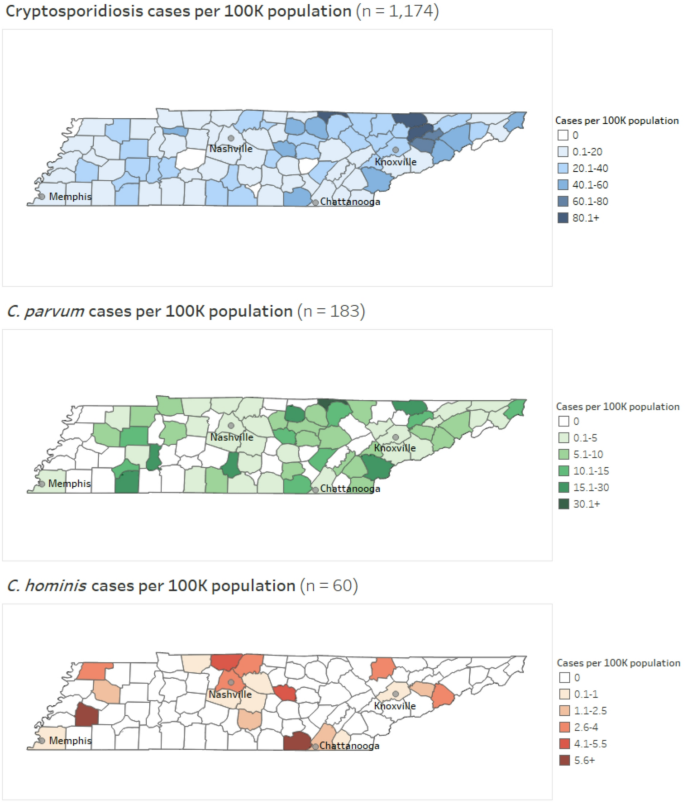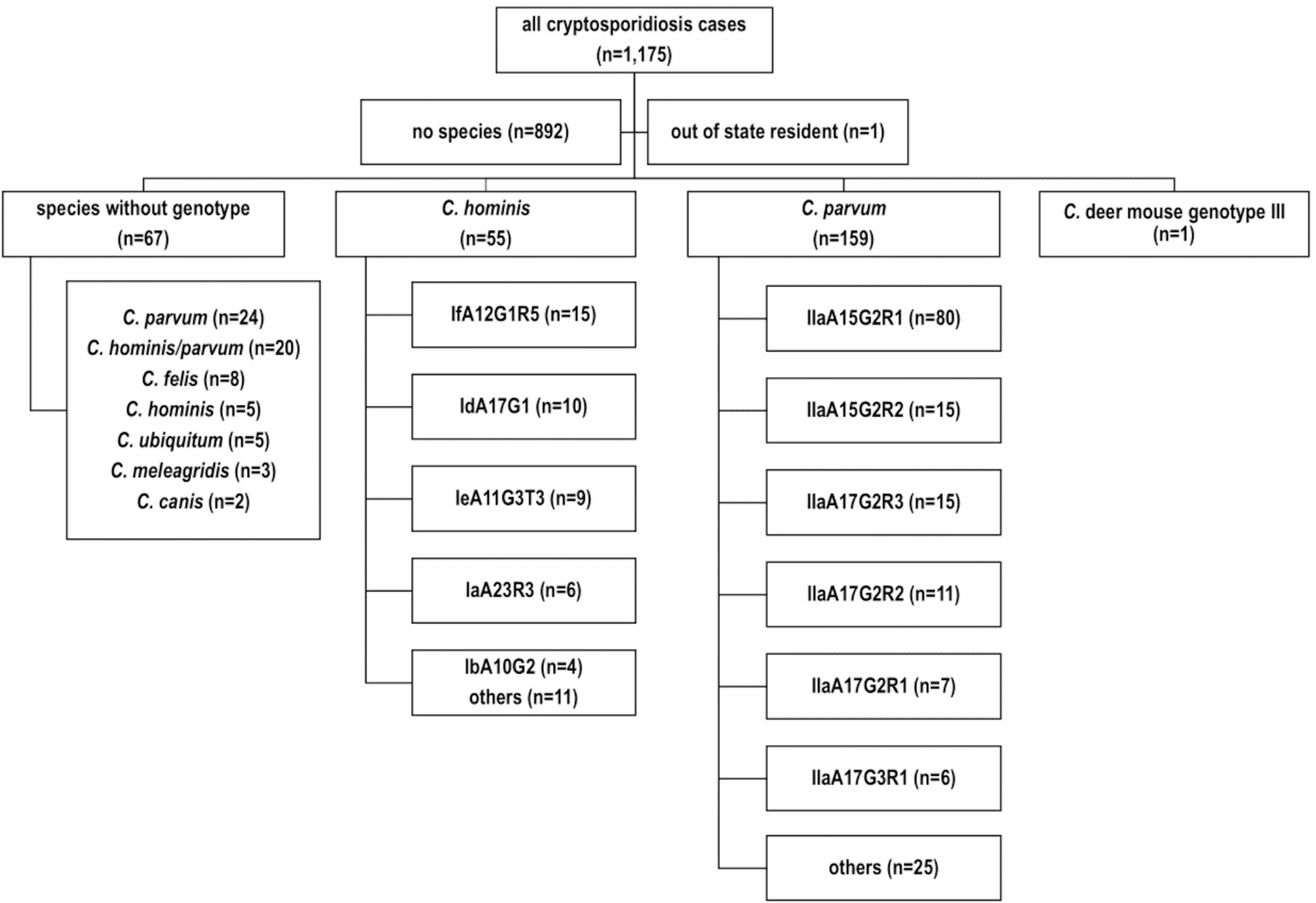Characteristics of all cryptosporidiosis cases
During 2018–2023, 1174 cryptosporidiosis cases were identified in Tennessee with a rate of 2.8 cases per 100,000 population (95% CI = 2.67–3.00). Forty-nine (4.2%) cases were associated with an identified outbreak. There were four reported cryptosporidiosis outbreaks in Tennessee during 2018–2023 that included four cases in a 2018 outbreak linked to transmission of C. parvum genotype IIaA15G2R1 at a restaurant, 20 cases in a 2021 outbreak without species information linked to a splashpad, eight cases in a 2022 outbreak linked to person-to-person transmission of C. hominis genotype IdA17G1 at a daycare, and 17 cases in a 2023 outbreak linked to person-to-person transmission of C. hominis genotype IfA12G1R5 at a daycare.
Of all 1174 reported cases in Tennessee, 1084 (92%) had laboratory confirmation of Cryptosporidium infection, 282 (24%) included species information, and 214 (18%) had genotype results (Fig. 1). Ninety (8%) cases were clinically compatible illnesses in people who had epidemiologic linkage to a person with laboratory confirmed Cryptosporidium infection. The most common clinical diagnostic test to confirm Cryptosporidium infection was polymerase chain reaction (n = 761, 65%) followed by enzyme immunoassay (n = 180, 15%) and rapid antigen (n = 102, 9%) testing (Supplemental Table 2). For 802 laboratory-confirmed Cryptosporidium cases without species information, 664 (83%) did not have a specimen submitted to the state public health laboratory for additional characterization.
Cryptosporidium species and genotypes reported in Tennessee, 2018–2023
Among all 1174 cases, 624 (55%) occurred in female persons. Three hundred seventy-four (32%) persons were aged less than 18 years, 631 (54%) were aged 18–64 years, and 169 (14%) were aged 65 years or older. Most (n = 970, 83%) persons reported White race. Animal contact was reported by 638 (54%) persons and most frequently included visiting or living on a farm (n = 231, 20%) and pet ownership (n = 101, 9%). Drinking water sources were municipal water (n = 792, 67%) and well water (n = 96, 8%). Recent international travel was reported in 72 (6%) cases and contact with a person with diarrheal illness in 103 (9%) cases. Exposure information was similar between cases with and without Cryptosporidium genotype results (Supplemental Table 3).
Characteristics of cryptosporidiosis cases by common species
Six different Cryptosporidium species were identified from 282 cases with available species information. C. parvum (n = 183, 65%) and C. hominis (n = 60, 21%) were the most frequently identified species followed by C. felis (n = 8, 3%) and C. ubiquitum (n = 5, 2%). Also present were C. meleagridis (n = 3), C. canis (n = 2). There were two cases with Cryptosporidium deer mouse subtype identified, one of which was initially reported in 2018 as C. parvum Deer Mouse Subtype and the other reported in 2023 as C. deer mouse genotype III.
Distribution of Cryptosporidium cases varied by county with C. parvum rate higher in rural (non-core and micropolitan) counties and C. hominis in urban (large central and fringe metropolitan) counties (Fig. 2). C. felis and C. ubiquitum were identified in both urban and rural counties. Children aged younger than 18 years accounted for 54% (n = 98) of C. parvum, 40% (n = 24) of C. hominis, 37% (n = 3) of C. felis, and 80% (n = 4) of C. ubiquitum cases. Report of animal contact ranged from 38% (n = 3) of persons with C. felis to 65% (n = 118) of persons with C. parvum. Recent international travel ranged from 0% of persons with C. felis or C. ubiquitum to 22% (n = 13) of persons with C. hominis. Contact with a person with diarrheal illness ranged from 0% of persons with C. felis or C. ubiquitum to 28% (n = 17) of persons with C. hominis (Table 1).

Cryptosporidiosis rate per 100,000 population in Tennessee, 2018–2023
Persons with C. parvum infections reported drinking well water more frequently than the general population (13% vs. 7%, P <.01). Contact with animals or their environment was more frequently reported by persons with C. parvum infections compared to the population and included visiting a farm or zoo (42% vs. 14%, P <.01); contact with a goat, cow, or sheep (39% vs. 6%, P <.01); and contact with a chicken or turkey (17% vs. 8%, P <.01). Contact with multiple animals was possible. Of 32 responses that included exposure to chicken or turkeys, 26 (81%) also included ruminant animal exposure, and 21 (66%) specifically exposure to cows (Table 2).
Persons with C. hominis infections reported recreational exposure to both natural and treated bodies of water more frequently (22% vs. 9%, P <.01 and 32% vs. 12%, P <.01) than the general population. Persons with C. hominis also more frequently reported having contact with another person with diarrheal illness compared to the population (28% vs. 15%, P =.01). Compared to the population, persons with both C. parvum and C. hominis infections less frequently reported cat (39% vs. 19% and 8%, respectively, P <.001) and dog (72% vs. 43% and 37%, respectively, P <.001) contact (Table 2).
Characteristics of Cryptosporidium cases by common genotypes
Among 214 total C. parvum (n = 159, 74%) and C. hominis (n = 55, 26%) cases with genotyping results, 38 subtypes were identified (Supplemental Table 3). Most frequently identified subtypes for C. parvum cases were IIaA15G2R1 (n = 80, 50%), IIaA15G2R2 (n = 15, 9%), IIaA17G2R3 (n = 15, 9%) and IIaA17G2R2 (n = 11, 7%). For all four subtypes, exposure to goat, cow, or chicken was more common than reported exposure among the population (49%, 53%, 40%, and 45% vs. 6%, P <.01 for all). Subtypes IIaA15G2R1, IIaA15G2R2, and IIaA17G2R2 were associated with visiting a farm or zoo (48%, 53%, and 55% vs. 14%, P <.01 for all). Subtypes IIaA15G2R1, IIaA15G2R2, and IIaA17G2R2 were associated with visiting a farm or live animal exhibit (48%, 53%, and 55% vs. 14%, P <.01 for all), and subtype IIaA15G2R1 with exposure to chicken or turkey (20% vs. 8%, P <.01). For C. hominis cases, the most frequently identified subtypes IfA12G1R5 (n = 15, 27%) and IdA17G1 (n = 10, 18%) were not associated with exposure to any of the assessed variables compared to the population (Table 2).
